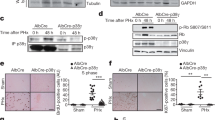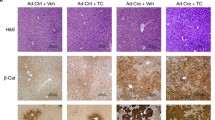Abstract
Cyclic AMP (cAMP) is an important regulator of liver growth and differentiation. The main intracellular cAMP receptor, cAMP-dependent protein kinase (PKA), consists of two regulatory (R) and two catalytic (C) subunits. There are two classes, RI and RII, of the regulatory subunit, giving rise to type I (RI2C2) and type II (RII2C2) PKA. The RI/RII ratio generally decreases during organ development, and increases during carcinogenesis. Alterations in this ratio have been implicated as an important factor in experimental and clinical carcinogenesis. We have studied the expression of RIα, RIIα, Cα, and an important substrate of PKA, the cAMP-response element binding protein, during rat liver carcinogenesis. Two-color immunofluorescence and confocal laser scan microscopy were used to characterize localization of the cAMP-dependent signal transducers in hepatocytes, bile ducts, oval cells, and preneoplastic lesions. We found that bile ducts and oval cells (putative liver stem cells) contained a higher RI/RII ratio than hepatocytes and preneoplastic lesions. Thus, an altered RI/RII ratio was not detected during early rat liver carcinogenesis, but may contribute to differentiation of putative liver stem cells to hepatocytes.
Similar content being viewed by others
Author information
Authors and Affiliations
Additional information
Accepted: 19 August 1997
Rights and permissions
About this article
Cite this article
Skarpen, E., Thoresen, G., Taskén, K. et al. Localization of cAMP-dependent signal transducers in early rat liver carcinogenesis. Histochemistry 109, 203–209 (1998). https://doi.org/10.1007/s004180050219
Issue Date:
DOI: https://doi.org/10.1007/s004180050219




